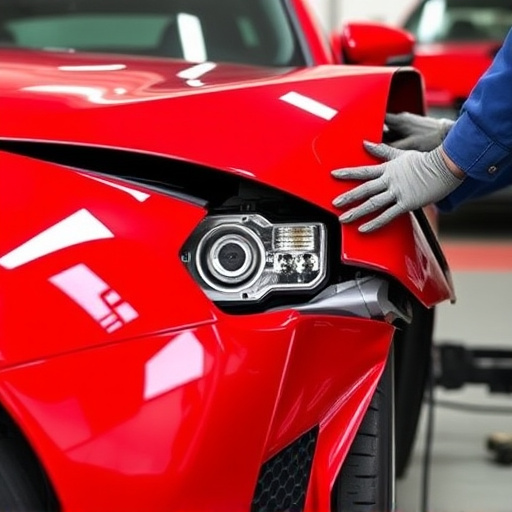The automotive industry is shifting towards hybrid and electric vehicles (HEVs) for sustainability, driving the adoption of lightweight materials like aluminum body components. Aluminum offers superior strength-to-weight ratio, improved fuel efficiency, reduced environmental impact, and easier repair compared to steel. Its versatility benefits both new car manufacturing and retrofitting, enhancing vehicle aerodynamics and aesthetics. Despite minor challenges in dent removal, the advantages of aluminum significantly contribute to greener, lighter, and safer HEVs as demand continues to grow.
The automotive industry is experiencing a significant shift towards sustainability, and aluminum body components are at the forefront of this revolution. This article explores the rising demand for lightweight materials in hybrid and electric vehicles (HEVs), highlighting how aluminum offers a powerful solution to enhance efficiency and reduce environmental impact. We delve into the technical advantages, from superior strength-to-weight ratios and corrosion resistance to innovative manufacturing processes, providing an in-depth look at aluminum’s role in shaping the future of EV and HEV design.
- The Rise of Aluminum in Automotive Industry for Sustainability
- – Exploring the demand for lightweight materials in hybrid and electric vehicles (HEVs)
- – Benefits of aluminum body components: reduced weight, improved efficiency, and environmental impact
The Rise of Aluminum in Automotive Industry for Sustainability

The automotive industry is undergoing a significant transformation with the rise of hybrid and electric vehicles (EVs). One key material driving this change is aluminum. Aluminum body components offer a sustainable alternative to traditional steel, providing lighter weight, improved fuel efficiency, and reduced environmental impact. As the demand for greener transportation solutions increases, manufacturers are increasingly turning to aluminum due to its exceptional strength-to-weight ratio, enabling more efficient and eco-friendly vehicles.
This shift towards aluminum is not just about sustainability; it also promises advancements in vehicle performance and durability. Unlike some materials that may require extensive vehicle repair or car body restoration processes, aluminum can be easily worked and repaired, making it ideal for both new car manufacturing and retrofitting existing models. Furthermore, the versatility of aluminum allows for innovative designs, contributing to improved aerodynamics and overall vehicle aesthetics without compromising on strength. This makes aluminum an attractive option not just for the environmental benefits but also for its practical advantages in terms of car paint repair and long-term performance.
– Exploring the demand for lightweight materials in hybrid and electric vehicles (HEVs)

In today’s rapidly evolving automotive landscape, there is an undeniable shift towards hybrid and electric vehicles (HEVs). This transition is driven by a growing demand for sustainable transportation options that offer improved fuel efficiency and reduced environmental impact. As such, the need for lightweight materials in vehicle construction has never been more pressing. Traditional steel bodies have long been the standard, but with the rise of HEVs, manufacturers are increasingly turning to aluminum body components to meet this new requirement.
Aluminum offers significant advantages over steel when it comes to weight reduction. Its inherent lightness and strength make it an ideal choice for car body repair and structural integrity in hybrid and electric vehicles. Moreover, aluminum is highly recyclable, contributing further to the sustainability goal. While dent removal techniques may vary slightly for aluminum compared to steel, the benefits of using this material far outweigh any additional considerations. Ultimately, as the demand for HEVs continues to surge, the adoption of aluminum body components will play a crucial role in shaping the future of greener and lighter vehicles.
– Benefits of aluminum body components: reduced weight, improved efficiency, and environmental impact

Aluminum body components offer a multitude of advantages for hybrid and electric vehicles. One of the most significant benefits is reduced weight. By replacing traditional steel bodies with aluminum, automakers can achieve substantial weight savings. This lighter structure directly translates to improved fuel efficiency, as less energy is required to propel the vehicle. Furthermore, the environmental impact of these components is minimal due to aluminum’s recyclability and lower production emissions compared to steel.
In addition to its eco-friendly attributes, aluminum provides excellent structural integrity, ensuring the safety and durability of vehicles. This metal is known for its strength-to-weight ratio, making it a preferred choice in automotive design, especially for electric vehicles with complex battery packs that require robust yet lightweight enclosures. Moreover, aluminum body components can facilitate easier and more cost-effective car dent repair and collision repair services, contributing to the overall efficiency of vehicle maintenance and ownership.
The increasing adoption of hybrid and electric vehicles has sparked a significant shift towards lightweight materials, with aluminum body components leading this revolution. The automotive industry is embracing sustainability by reducing overall vehicle weight, boosting fuel efficiency, and minimizing environmental impact. As technology advances, further development in aluminum alloys and manufacturing processes will only enhance its dominance in the HEV market, making it an indispensable material for a greener future on the roads.












